Abstract
1. The influences on respiratory frequency of ambient temperature, the temperature of the skin, the temperature and humidity of the inspired air, hypothalamic temperature, the temperature of the spinal cord, rectal temperature and some temperatures in the abdomen have been studied in the pig.
2. At a constant ambient temperature the effect on respiratory frequency of heating a thermode in the hypothalamus was modified by the temperature of the skin of the trunk which was varied independently by means of a temperature-controlled coat. A cold skin inhibited panting; a warm skin enhanced panting. The effect of heating a thermode over the spinal cord was similarly modified by skin temperatures.
3. Simultaneous heating of thermodes in the hypothalamus and spinal cord increased respiratory frequency more than heating either alone, and in a warm environment the rectal temperature influenced the extent to which respiratory frequency increased on heating the thermodes.
4. Cooling the thermodes decreased respiratory frequency in a warm environment and the cooling of one thermode enhanced the effect of cooling the other.
5. At a constant trunk skin temperature the effect on respiratory frequency of heating the thermode in the hypothalamus depended on ambient temperature.
6. Changing the temperature of thermodes in the abdomen did not affect respiration nor was there any evidence that the temperature and humidity of the inspired air had a direct effect on respiration.
Full text
PDF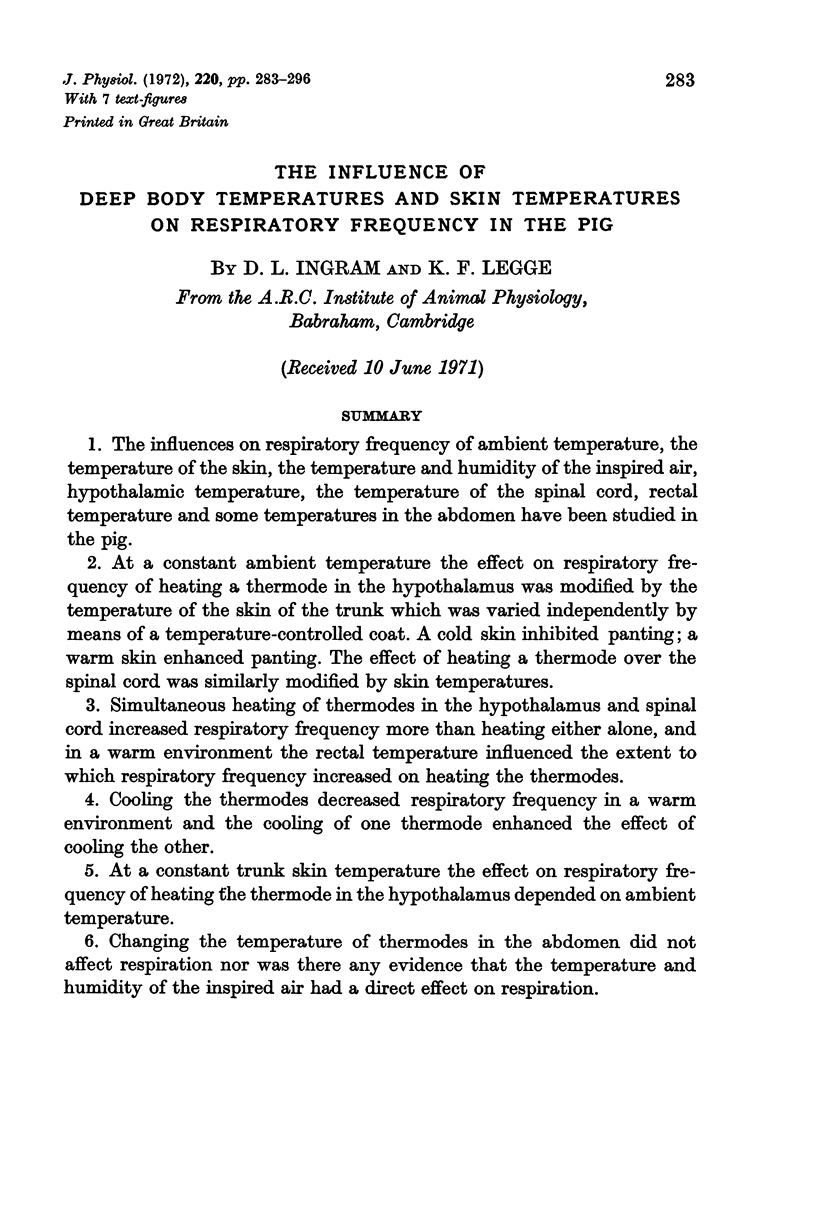
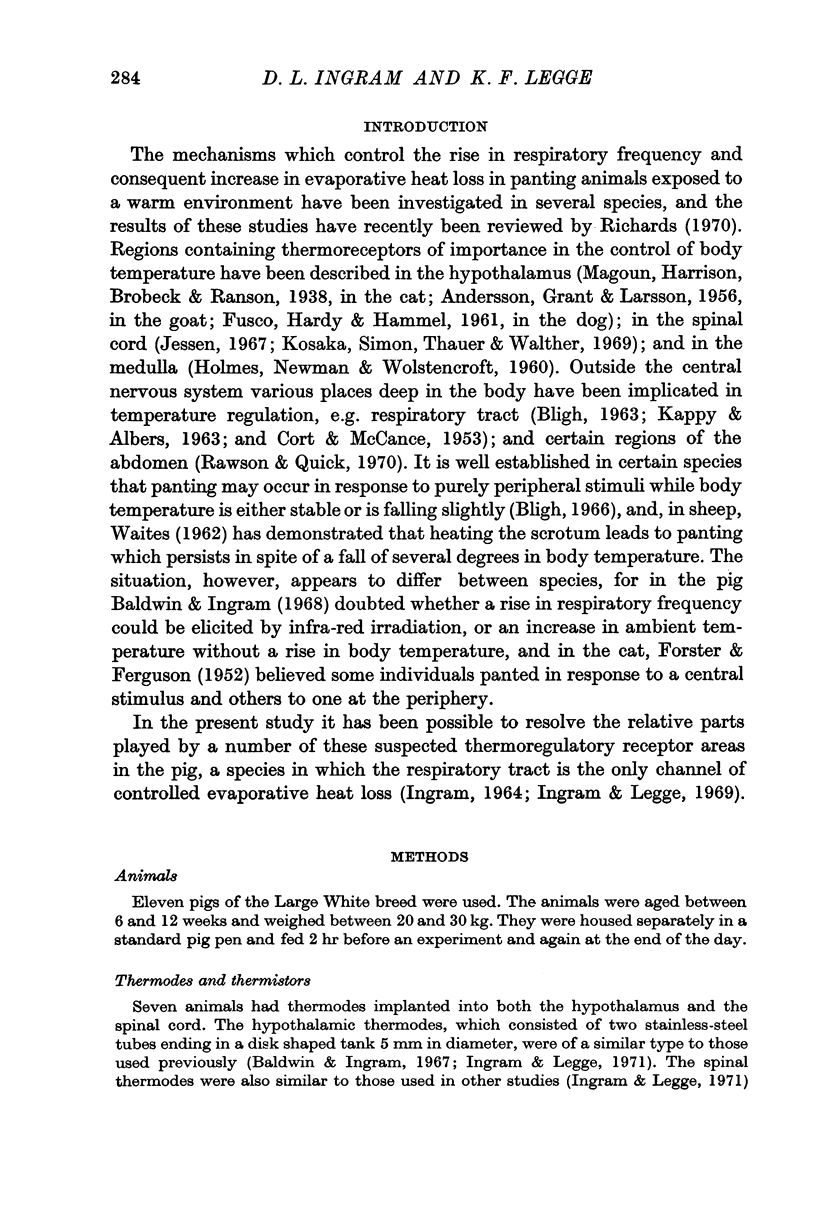
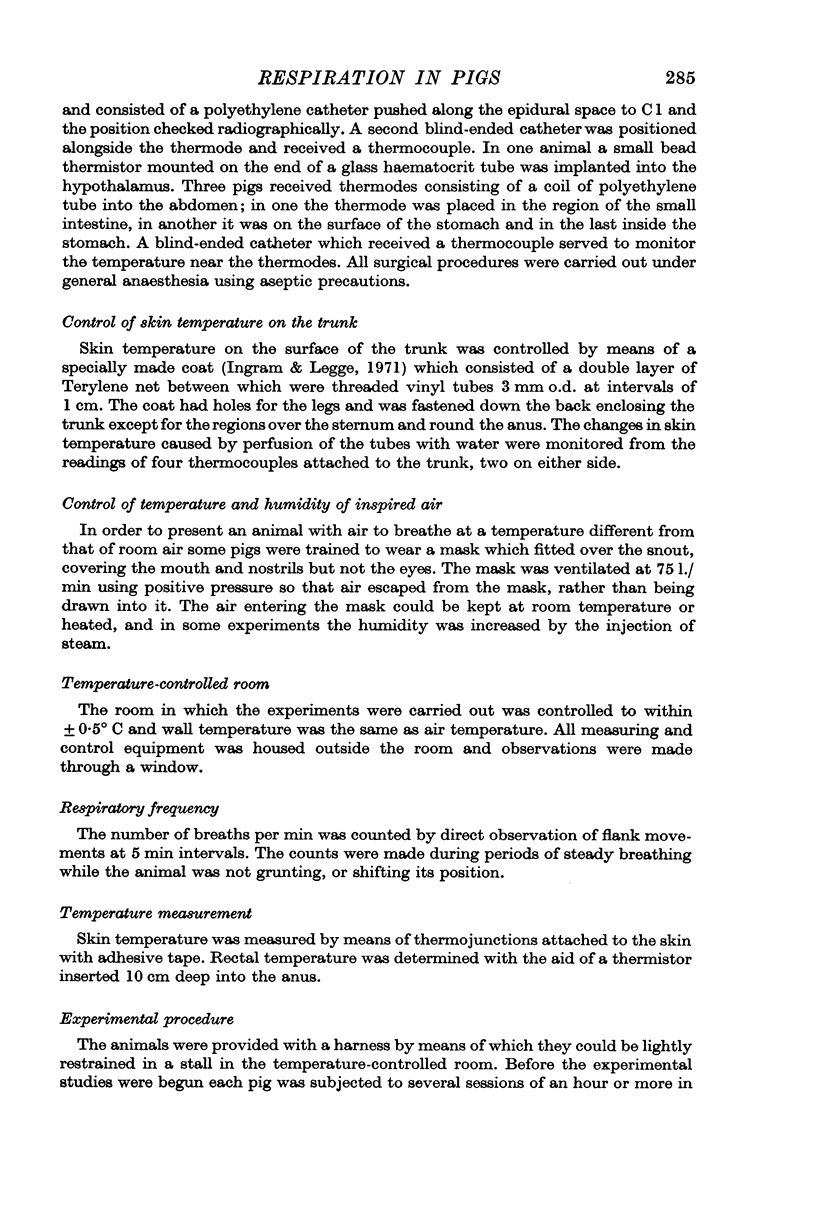
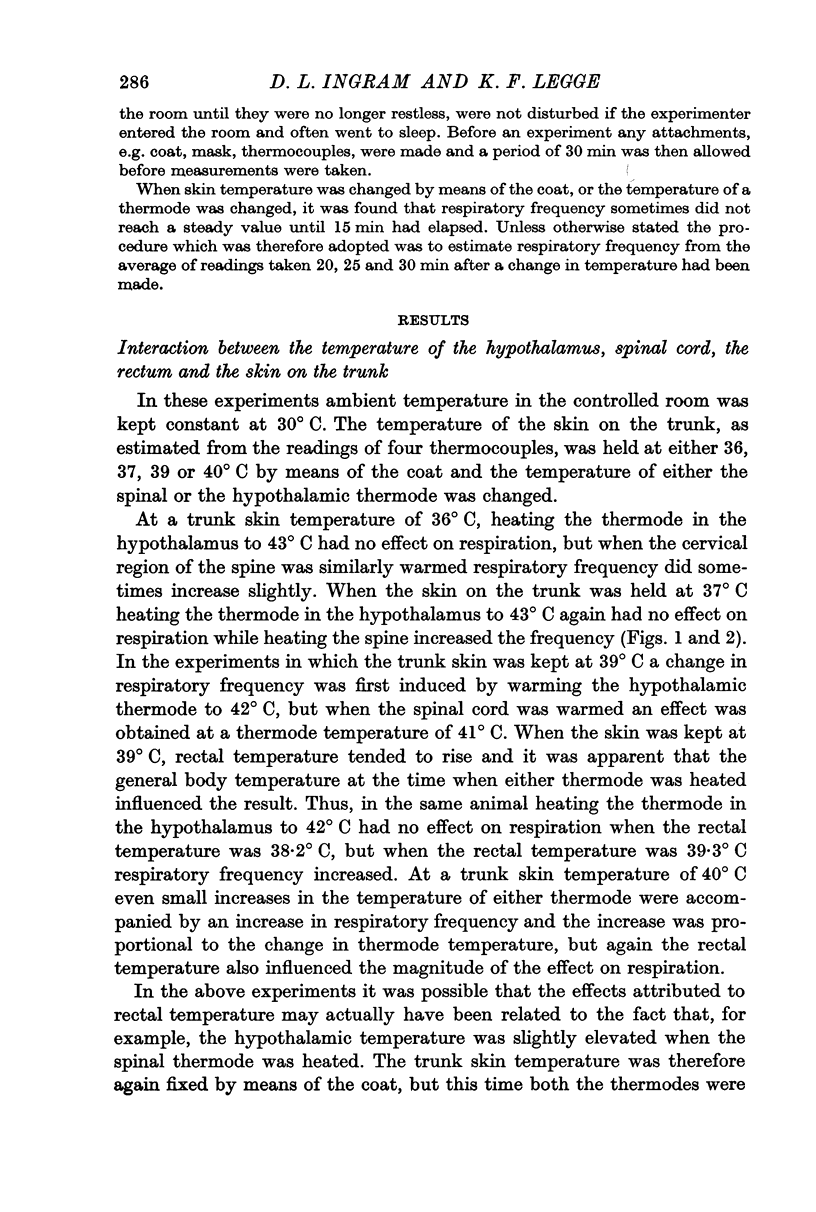
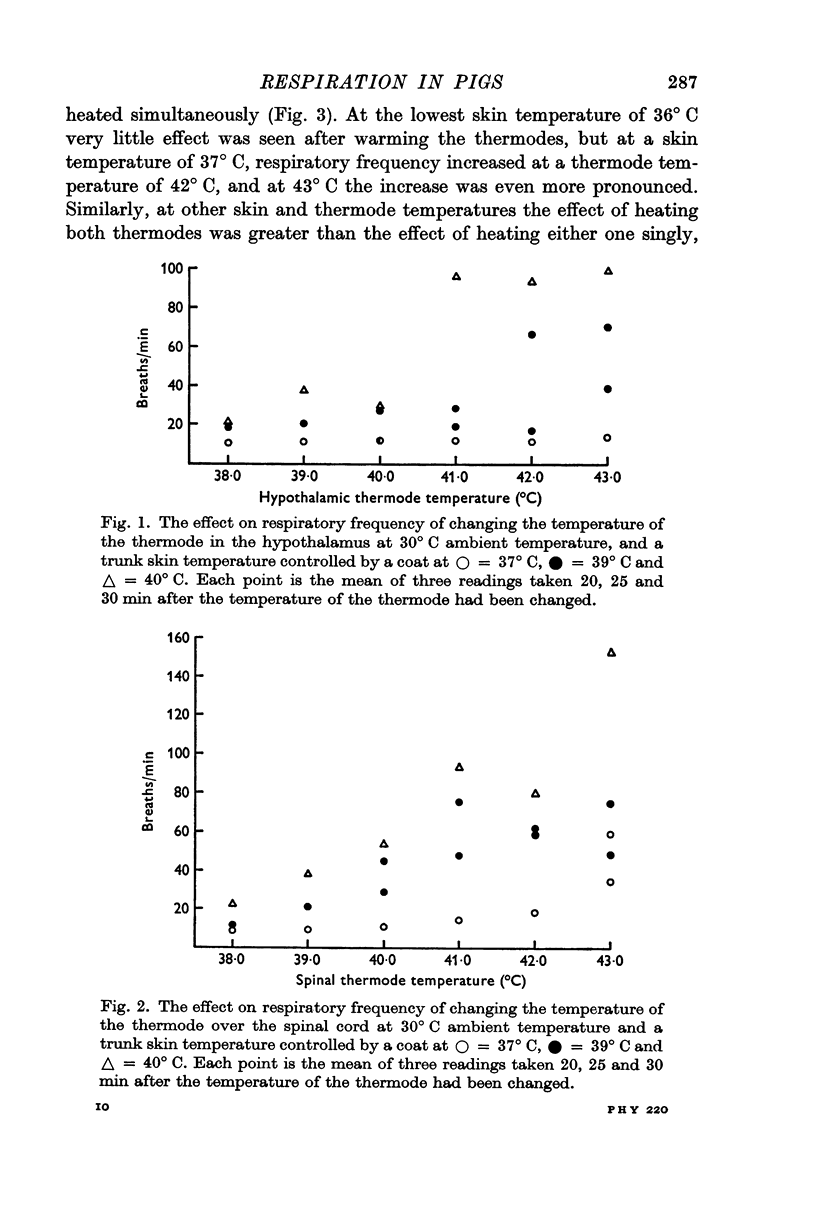
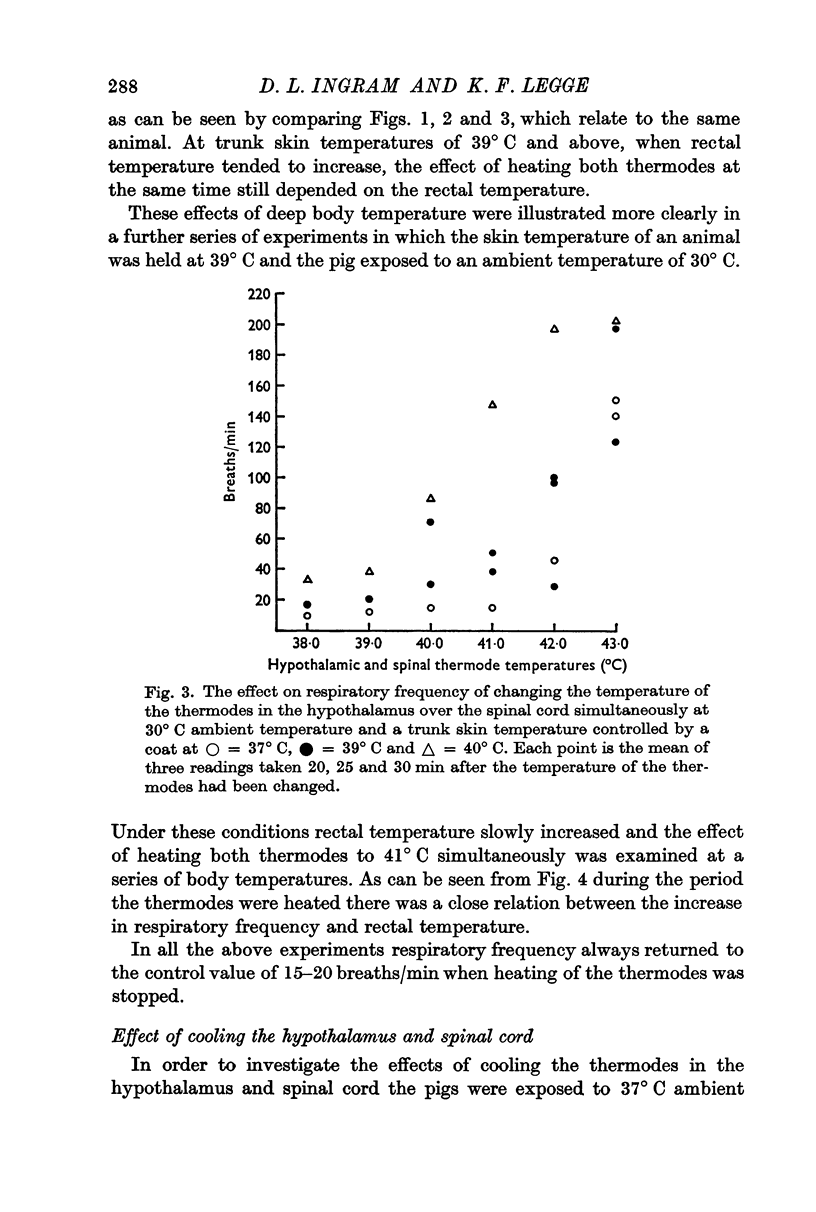
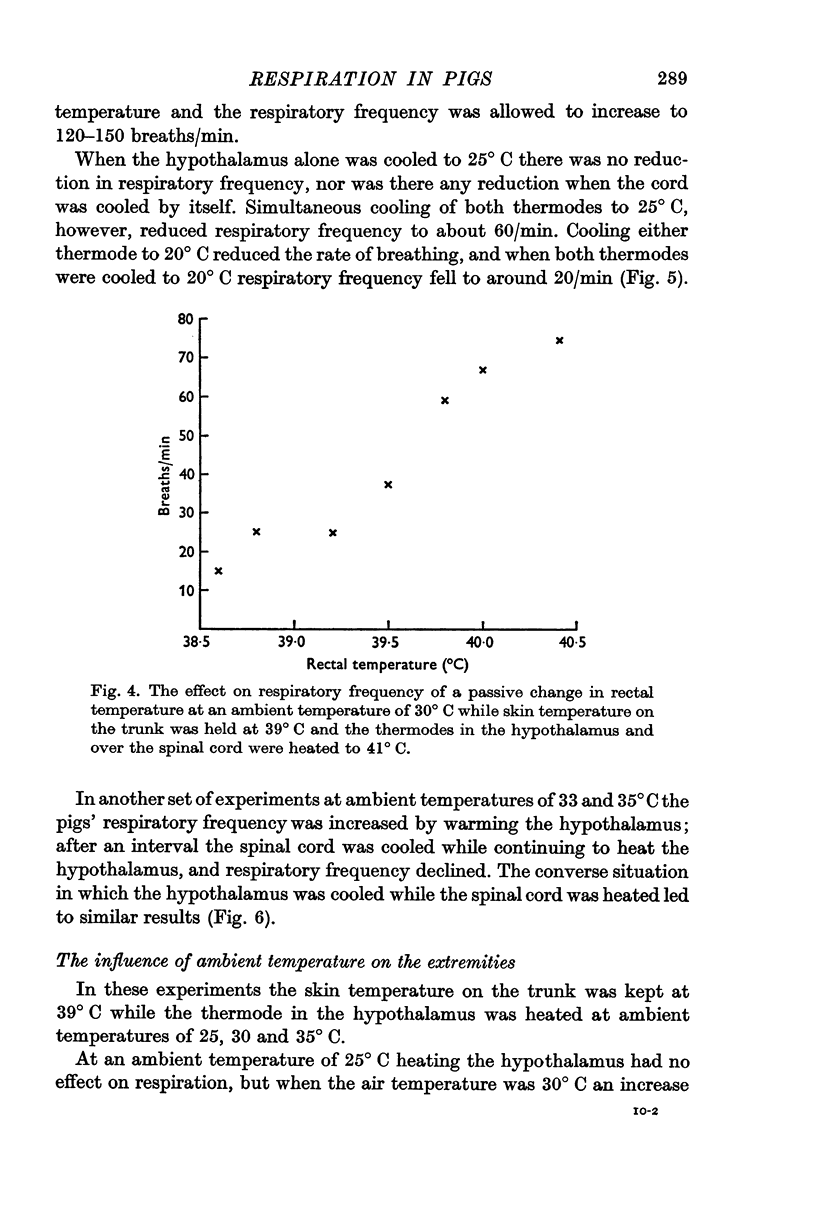
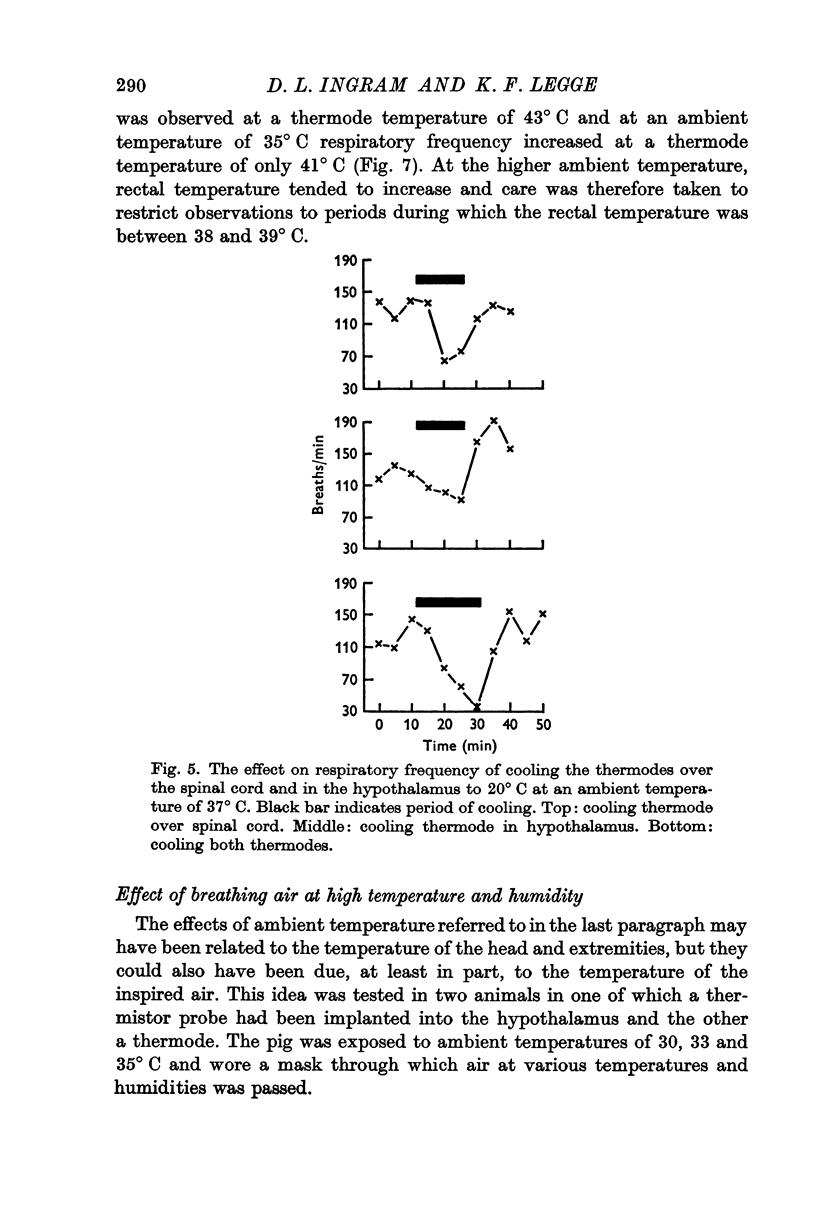
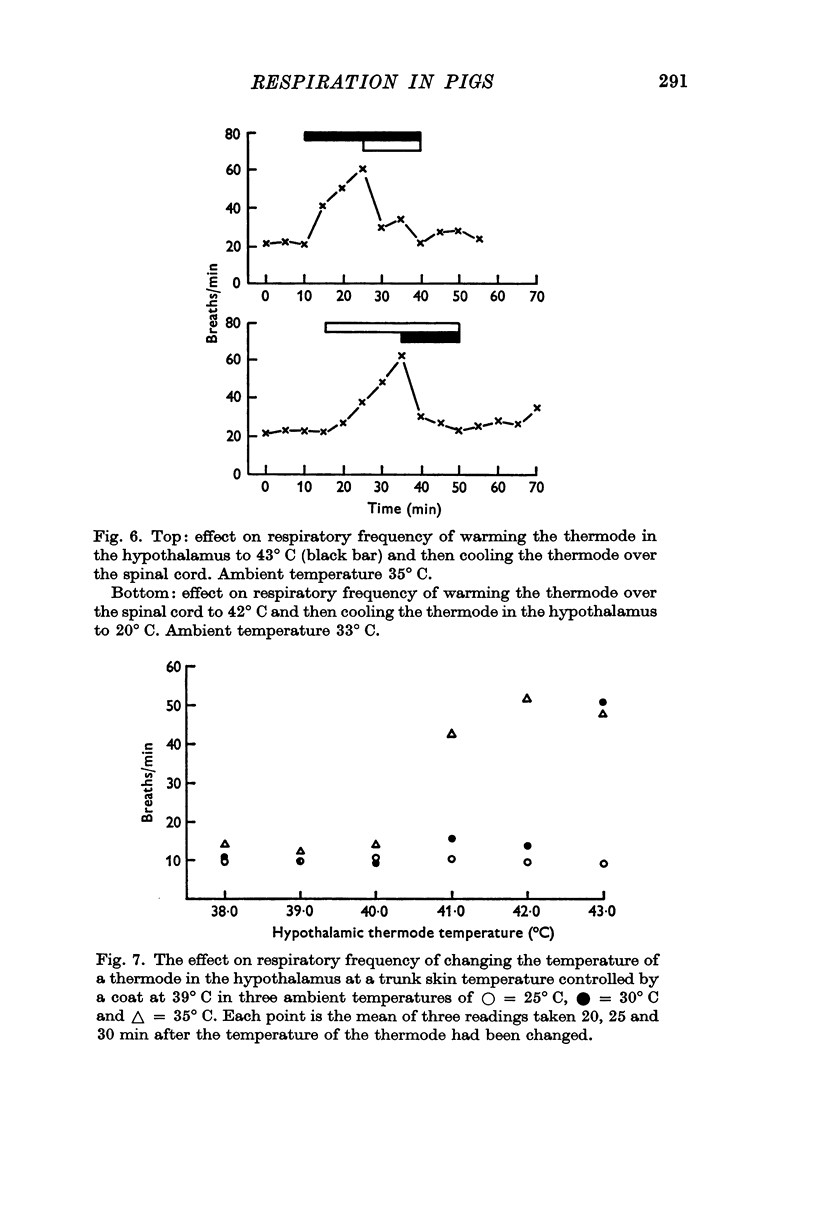
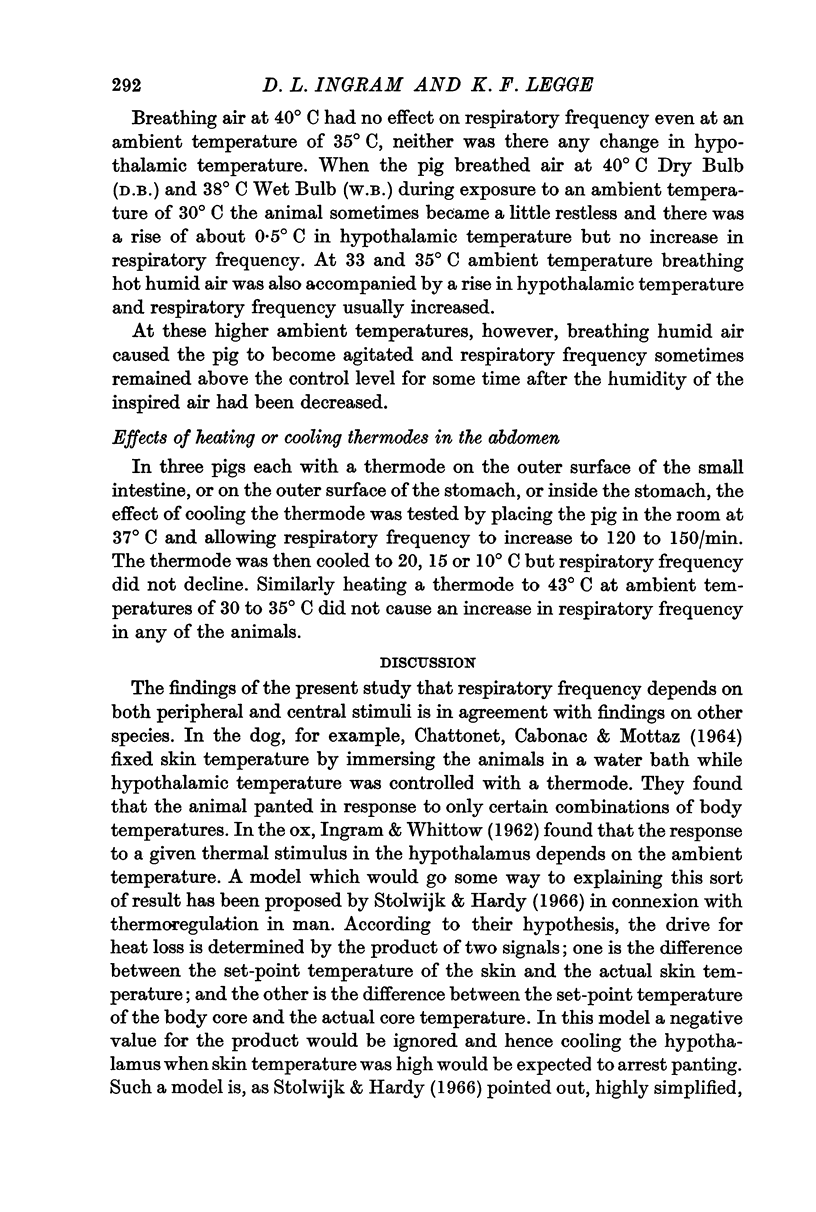
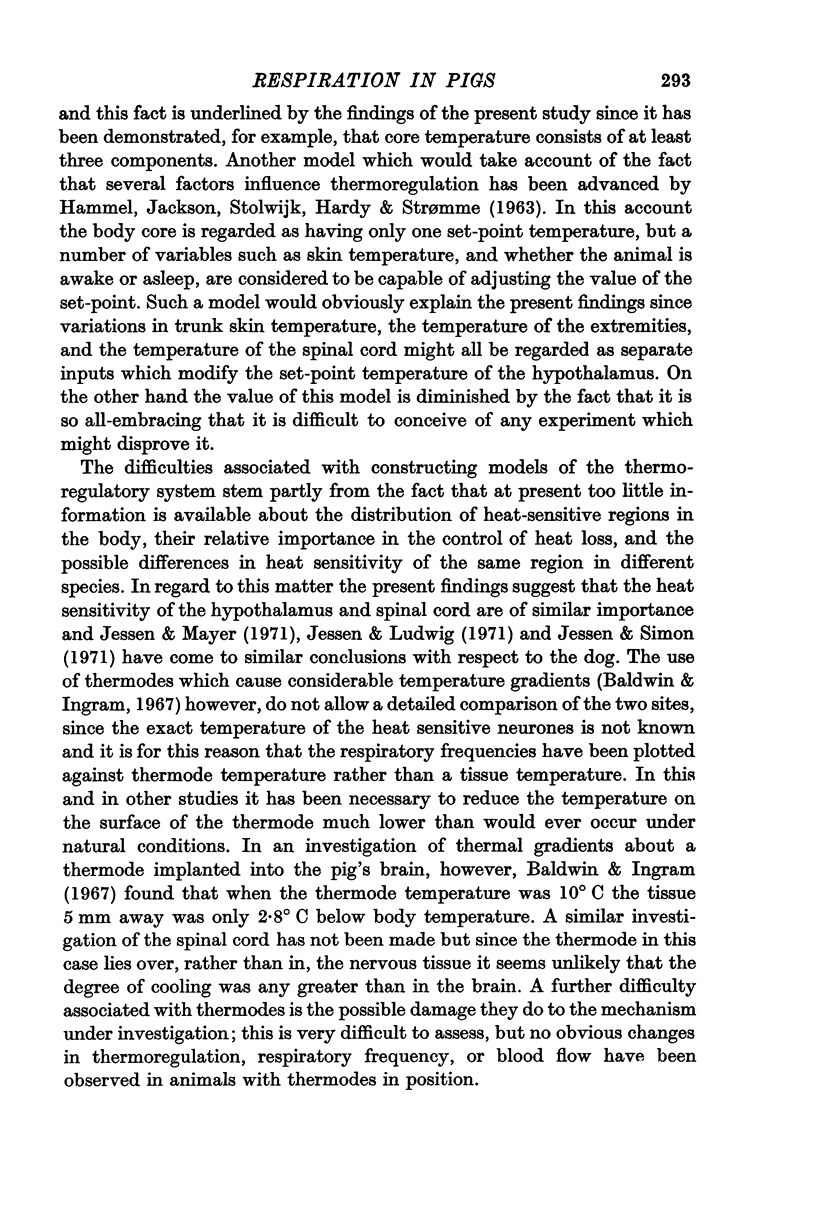
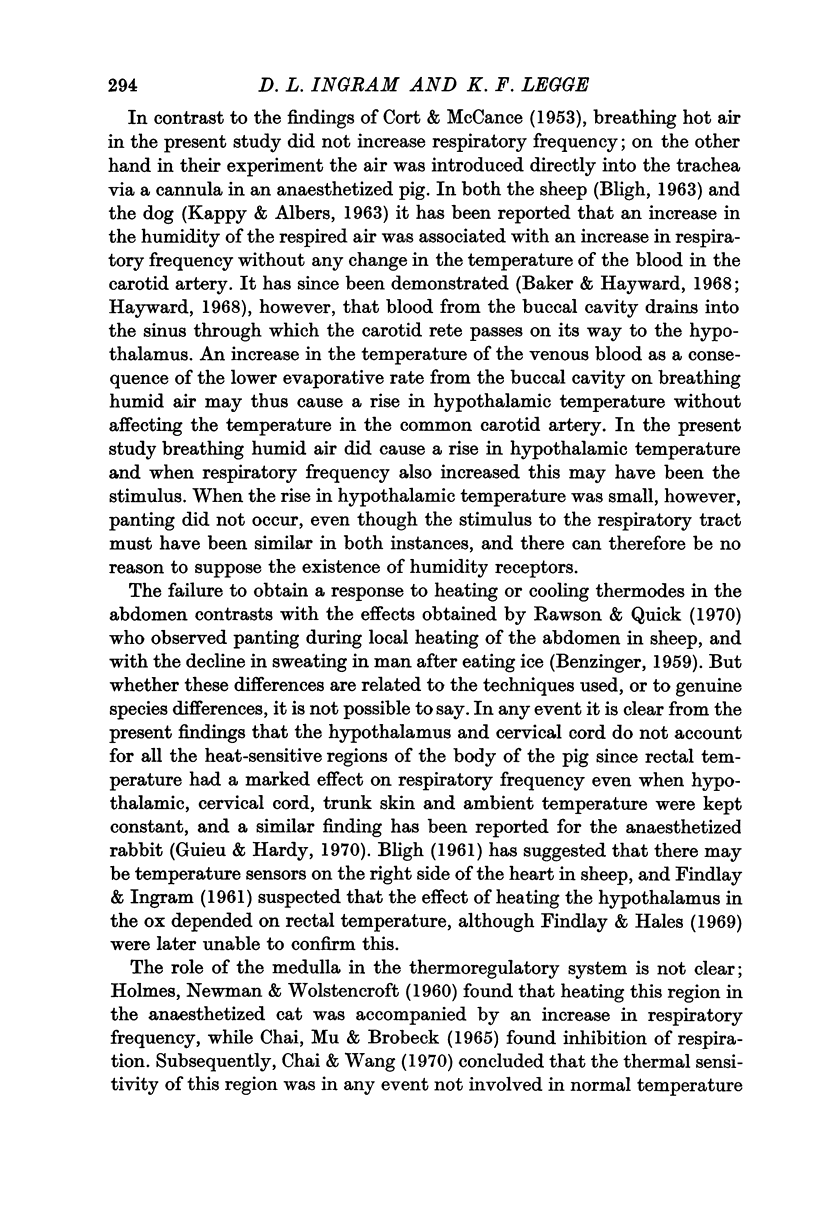
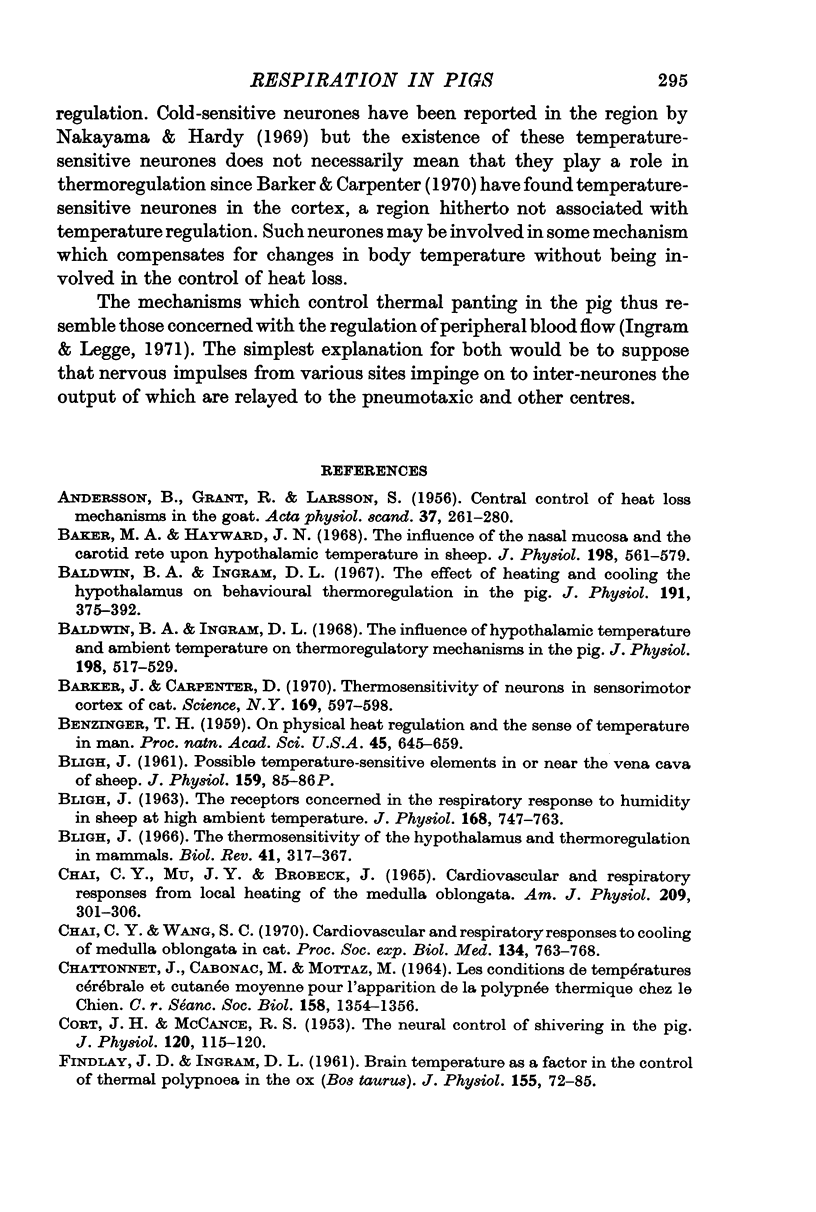
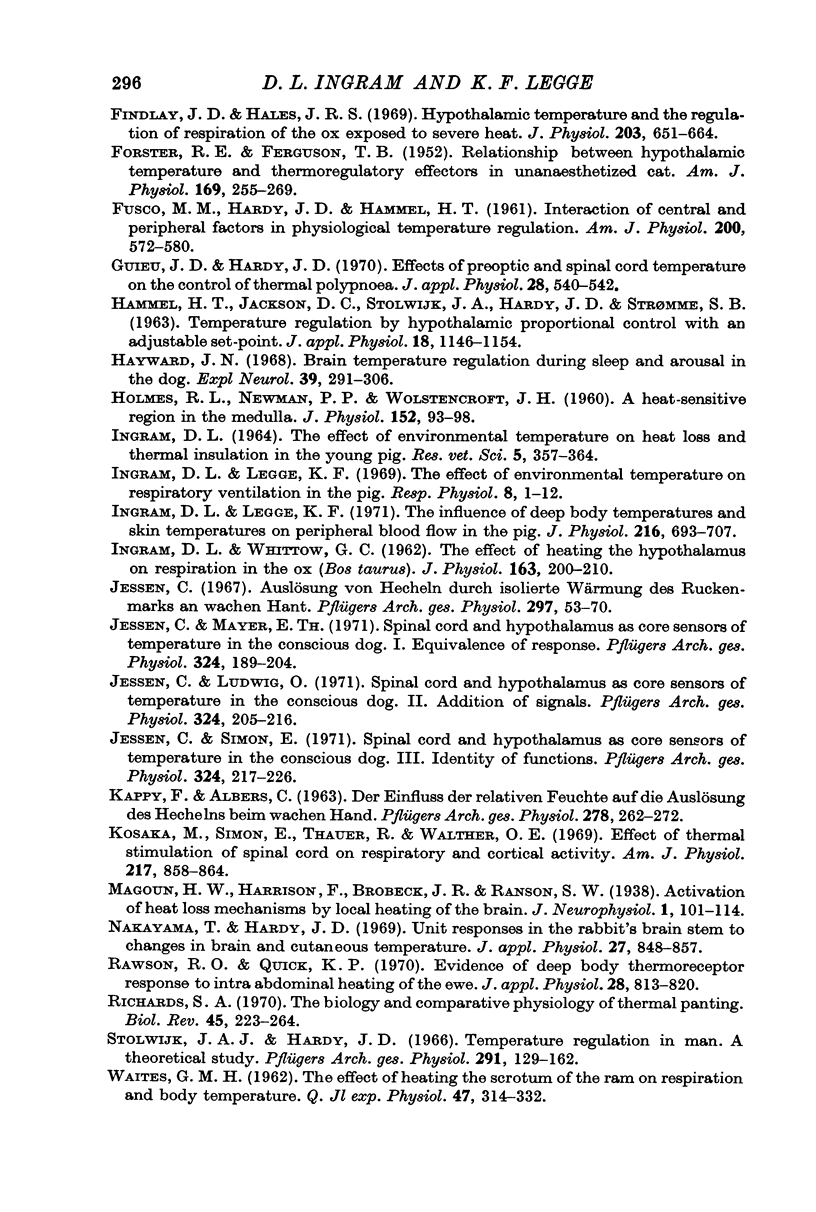
Selected References
These references are in PubMed. This may not be the complete list of references from this article.
- ANDERSSON B., GRANT R., LARSSON S. Central control of heat loss mechanisms in the goat. Acta Physiol Scand. 1956 Sep 26;37(2-3):261–280. doi: 10.1111/j.1748-1716.1956.tb01362.x. [DOI] [PubMed] [Google Scholar]
- BLIGH J. THE RECEPTORS CONCERNED IN THE RESPIRATORY RESPONSE TO HUMIDITY IN SHEEP AT HIGH AMBIENT TEMPERATURE. J Physiol. 1963 Oct;168:747–763. doi: 10.1113/jphysiol.1963.sp007220. [DOI] [PMC free article] [PubMed] [Google Scholar]
- Baker M. A., Hayward J. N. The influence of the nasal mucosa and the carotid rete upon hypothalamic temperature in sheep. J Physiol. 1968 Oct;198(3):561–579. doi: 10.1113/jphysiol.1968.sp008626. [DOI] [PMC free article] [PubMed] [Google Scholar]
- Baldwin B. A., Ingram D. L. Effect of heating & cooling the hypothalamus on behavioral thermoregulation in the pig. J Physiol. 1967 Jul;191(2):375–392. doi: 10.1113/jphysiol.1967.sp008256. [DOI] [PMC free article] [PubMed] [Google Scholar]
- Baldwin B. A., Ingram D. L. The influence of hypothalamic temperature and ambient temperature on thermoregulatory mechanisms in the pig. J Physiol. 1968 Oct;198(3):517–529. doi: 10.1113/jphysiol.1968.sp008622. [DOI] [PMC free article] [PubMed] [Google Scholar]
- Barker J. L., Carpenter D. O. Thermosensitivity of neurons in the sensorimotor cortex of the cat. Science. 1970 Aug 7;169(3945):597–598. doi: 10.1126/science.169.3945.597. [DOI] [PubMed] [Google Scholar]
- Benzinger T. H. ON PHYSICAL HEAT REGULATION AND THE SENSE OF TEMPERATURE IN MAN. Proc Natl Acad Sci U S A. 1959 Apr;45(4):645–659. doi: 10.1073/pnas.45.4.645. [DOI] [PMC free article] [PubMed] [Google Scholar]
- Bligh J. The thermosensitivity of the hypothalamus and thermoregulation in mammals. Biol Rev Camb Philos Soc. 1966 Aug;41(3):317–368. doi: 10.1111/j.1469-185x.1966.tb01496.x. [DOI] [PubMed] [Google Scholar]
- CHAI C. Y., MU J. Y., BROBECK J. R. CARDIOVASCULAR AND RESPIRATORY RESPONSES FROM LOCAL HEATING OF MEDULLA OBLONGATA. Am J Physiol. 1965 Aug;209:301–306. doi: 10.1152/ajplegacy.1965.209.2.301. [DOI] [PubMed] [Google Scholar]
- CHATONNET J., CABANAC M., MOTTAZ M. LES CONDITIONS DE TEMP'ERATURES C'ER'EBRALE ET CUTAN'EE MOYENNE POUR L'APPARITION DE LA POLYPN'EE THERMIQUE CHEZ LE CHIEN. C R Seances Soc Biol Fil. 1964;158:1354–1356. [PubMed] [Google Scholar]
- CORT J. H., MCCANCE R. A. The neural control of shivering in the pig. J Physiol. 1953 Apr 28;120(1-2):115–121. doi: 10.1113/jphysiol.1953.sp004877. [DOI] [PMC free article] [PubMed] [Google Scholar]
- Chai C. Y., Wang S. C. Cardiovascular and respiratory responses to cooling of the medulla oblongata of the cat. Proc Soc Exp Biol Med. 1970 Jul;134(3):763–767. doi: 10.3181/00379727-134-34878. [DOI] [PubMed] [Google Scholar]
- FINDLAY J. D., INGRAM D. L. Brain temperature as a factor in the control of thermal polypnoea in the ox (Bos taurus). J Physiol. 1961 Jan;155:72–85. doi: 10.1113/jphysiol.1961.sp006614. [DOI] [PMC free article] [PubMed] [Google Scholar]
- FORSTER R. E., FERGUSON T. B. Relationship between hypothalamic temperature and thermo-regulatory effectors in unanesthetized cat. Am J Physiol. 1952 May;169(2):255–269. doi: 10.1152/ajplegacy.1952.169.2.255. [DOI] [PubMed] [Google Scholar]
- FUSCO M. M., HARDY J. D., HAMMEL H. T. Interaction of central and peripheral factors in physiological temperature regulation. Am J Physiol. 1961 Mar;200:572–580. doi: 10.1152/ajplegacy.1961.200.3.572. [DOI] [PubMed] [Google Scholar]
- Findlay J. D., Hales J. R. Hypothalamic temperature and the regulation of respiration of the ox exposed to severe heat. J Physiol. 1969 Aug;203(3):651–663. doi: 10.1113/jphysiol.1969.sp008884. [DOI] [PMC free article] [PubMed] [Google Scholar]
- Guieu J. D., Hardy J. D. Effects of preoptic and spinal cord temperature in control of thermal polypnea. J Appl Physiol. 1970 Apr;28(4):540–542. doi: 10.1152/jappl.1970.28.4.540. [DOI] [PubMed] [Google Scholar]
- HAMMEL H. T., JACKSON D. C., STOLWIJK J. A., HARDY J. D., STROMME S. B. TEMPERATURE REGULATION BY HYPOTHALAMIC PROPORTIONAL CONTROL WITH AN ADJUSTABLE SET POINT. J Appl Physiol. 1963 Nov;18:1146–1154. doi: 10.1152/jappl.1963.18.6.1146. [DOI] [PubMed] [Google Scholar]
- HOLMES R. L., NEWMAN P. P., WOLSTENCROFT J. H. A heatsensitive region in the medulla. J Physiol. 1960 Jun;152:93–98. doi: 10.1113/jphysiol.1960.sp006472. [DOI] [PMC free article] [PubMed] [Google Scholar]
- INGRAM D. L., WHITTOW G. C. The effect of heating the hypothalamus on respiration in the ox (Bos taurus). J Physiol. 1962 Sep;163:200–210. doi: 10.1113/jphysiol.1962.sp006968. [DOI] [PMC free article] [PubMed] [Google Scholar]
- Ingram D. L., Legge K. F. The effect of environmental temperature on respiratory ventilation in the pig. Respir Physiol. 1969 Dec;8(1):1–12. doi: 10.1016/0034-5687(69)90041-3. [DOI] [PubMed] [Google Scholar]
- Ingram D. L., Legge K. F. The influence of deep body temperatures and skin temperatures on peripheral blood flow in the pig. J Physiol. 1971 Jul;215(3):693–707. doi: 10.1113/jphysiol.1971.sp009492. [DOI] [PMC free article] [PubMed] [Google Scholar]
- Jessen C. Auslösung von Hecheln durch isolierte Wärmung des Rückenmarks am wachen Hund. Pflugers Arch Gesamte Physiol Menschen Tiere. 1967;297(2):53–70. [PubMed] [Google Scholar]
- Jessen C., Ludwig O. Spinal cord and hypothalamus as core sensors of temperature in the conscious dog. II. Addition of signals. Pflugers Arch. 1971;324(3):205–216. doi: 10.1007/BF00586419. [DOI] [PubMed] [Google Scholar]
- Jessen C., Mayer E. T. Spinal cord and hypothalamus as core sensors of temperature in the conscious dog. I. Equivalence of responses. Pflugers Arch. 1971;324(3):189–204. doi: 10.1007/BF00586418. [DOI] [PubMed] [Google Scholar]
- Jessen C., Simon E. Spinal cord and hypothalamus as core sensors of temperature in the conscious dog. 3. Identity of functions. Pflugers Arch. 1971;324(3):217–226. doi: 10.1007/BF00586420. [DOI] [PubMed] [Google Scholar]
- KAPPEY F., ALBERS C. DER EINFLUSS DER RELATIVEN FEUCHTE AUF DIE AUSLOESUNG DES HECHELNS BEIM WACHEN HUND. Pflugers Arch Gesamte Physiol Menschen Tiere. 1963 Nov 11;278:262–272. [PubMed] [Google Scholar]
- Kosaka M., Simon E., Thauer R., Walther O. E. Effect of thermal stimulation of spinal cord on respiratory and cortical activity. Am J Physiol. 1969 Sep;217(3):858–864. doi: 10.1152/ajplegacy.1969.217.3.858. [DOI] [PubMed] [Google Scholar]
- Nakayama T., Hardy J. D. Unit responses in the rabbit's brain stem to changes in brain and cutaneous temperature. J Appl Physiol. 1969 Dec;27(6):848–857. doi: 10.1152/jappl.1969.27.6.848. [DOI] [PubMed] [Google Scholar]
- Rawson R. O., Quick K. P. Evidence of deep-body thermoreceptor response to intra-abdominal heating of the ewe. J Appl Physiol. 1970 Jun;28(6):813–820. doi: 10.1152/jappl.1970.28.6.813. [DOI] [PubMed] [Google Scholar]
- Stolwijk J. A., Hardy J. D. Temperature regulation in man--a theoretical study. Pflugers Arch Gesamte Physiol Menschen Tiere. 1966;291(2):129–162. doi: 10.1007/BF00412787. [DOI] [PubMed] [Google Scholar]
- WAITES G. M. The effect of heating the scrotum of the ram on respiration and body temperature. Q J Exp Physiol Cogn Med Sci. 1962 Oct;47:314–323. doi: 10.1113/expphysiol.1962.sp001615. [DOI] [PubMed] [Google Scholar]


